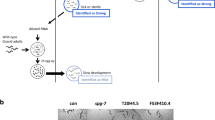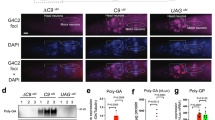Abstract
Mutations in the human presenilin genes cause the most frequent and aggressive forms of familial Alzheimer's disease (FAD)1. Here we show that in addition to its role in cell fate decisions in non-neuronal tissues2,3,4, presenilin activity is required in terminally differentiated neurons in vivo. Mutations in the Caenorhabditis elegans presenilin genes sel-12 and hop-1 result in a defect in the temperature memory of the animals. This defect is caused by the loss of presenilin function in two cholinergic interneurons that display neurite morphology defects in presenilin mutants. The morphology and function of the affected neurons in sel-12 mutant animals can be restored by expressing sel-12 only in these cells. The wild-type human presenilin PS1, but not the FAD mutant PS1 A246E, can also rescue these morphological defects. As lin-12 mutant animals display similar morphological and functional defects to presenilin mutants, we suggest that presenilins mediate their activity in postmitotic neurons by facilitating Notch signalling. These data indicate cell-autonomous and evolutionarily conserved control of neural morphology and function by presenilins.
This is a preview of subscription content, access via your institution
Access options
Subscribe to this journal
Receive 51 print issues and online access
$199.00 per year
only $3.90 per issue
Buy this article
- Purchase on Springer Link
- Instant access to full article PDF
Prices may be subject to local taxes which are calculated during checkout


Similar content being viewed by others
References
Haass, C. & De Strooper, B. The presenilins in Alzheimer's disease—proteolysis holds the key. Science 286 , 916–919 (1999).
Levitan, D. & Greenwald, I. Facilitation of lin-12-mediated signalling by sel-12, a Caenorhabditis elegans S182 Alzheimer's disease gene. Nature 377, 351– 354 (1995).
Levitan, D. et al. Assessment of normal and mutant human presenilin function in Caenorhabditis elegans. Proc. Natl Acad. Sci. USA 93, 14940–14944 (1996).
Baumeister, R. et al. Human presenilin-1, but not familial Alzheimer's disease (FAD) mutants, facilitate Caenorhabditis elegans Notch signalling independently of proteolytic processing. Genes Funct. 1, 149–159 (1997).
Hedgecock, E. M. & Russell, R. L. Normal and mutant thermotaxis in the nematode Caenorhabditis elegans. Proc. Natl Acad. Sci. USA 72, 4061– 4065 (1975).
Mori, I. & Ohshima, Y. Neural regulation of thermotaxis in Caenorhabditis elegans. Nature 376, 344–348 (1995).
White, J. G., Southgate, E., Thomson, J. N. & Brenner, S. The structure of the nervous system of the nematode Caenorhabditis elegans . Phil. Trans. R. Soc. Lond. 314, 1– 340 (1986).
Hedgecock, E. M., Culotti, J. G., Thomson, J. N. & Perkins, L. A. Axonal guidance mutants of Caenorhabditis elegans identified by filling sensory neurons with fluorescein dyes. Dev. Biol. 111 , 158–170 (1985).
Hobert, O. et al. Regulation of interneuron function in the C. elegans thermoregulatory pathway by the ttx-3 LIM homeobox gene. Neuron 19, 345–357 (1997).
Westlund, B., Parry, D., Clover, R., Basson, M. & Johnson, C. D. Reverse genetic analysis of Caenorhabditis elegans presenilins reveals redundant but unequal roles for sel-12 and hop-1 in Notch-pathway signaling. Proc. Natl Acad. Sci. USA 96, 2497–2502 ( 1999).
Kovacs, D. M. et al. Alzheimer-associated presenilins 1 and 2: Neuronal expression in brain and localization to intracellular membranes in mammalian cells. Nature Med. 2, 224–229 ( 1996).
Cook, D. G. et al. Expression and analysis of presenilin 1 in a human neuronal system: Localization in cell bodies and dendrites. Proc. Natl Acad. Sci. USA 93, 9223–9228 ( 1996).
Lee, M. K. et al. Expression of Presenilin 1 and 2 (PS1 and PS2) in human and murine tissues. J. Neurosci. 16, 7513 –7525 (1996).
Peckol, E., Zallen, J., Yarrow, J. & Bargmann, C. Sensory activity affects sensory axon development in C. elegans. Development 126, 1891–1902 ( 1999).
Lee, R., Lobel, L., Hengartner, M., Horvitz, H. & Avery, L. Mutations in the α1 subunit of an L-type voltage-activated Ca2+ channel cause myotonia in Caenorhabditis elegans. EMBO J. 16, 6066–6076 (1997).
Katayama, T. et al. Presenilin-1 mutations downregulate the signalling pathway of the unfolded-protein response. Nature Cell Biol. 1, 479–485 (1999).
Struhl, G. & Greenwald, I. Presenilin is required for activity and nuclear access of Notch in Drosophila. Nature 398, 522–525 (1999).
Wolfe, M. S. et al. Two transmembrane aspartates in presenilin-1 required for presenilin endoproteolysis and gamma-secretase activity. Nature 398, 513–517 ( 1999).
Ye, Y., Lukinova, N. & Fortini, M. E. Neurogenic phenotypes and altered Notch processing in Drosophila presenilin mutants. Nature 398 , 525–529 (1999).
Giniger, E., Jan, L. & Jan, Y. Specifying the path of the intersegmental nerve of the Drosophila embryo: a role for Delta and Notch. Development 117, 431–440 (1993).
Berezovska, O. et al. Notch1 inhibits neurite outgrowth in postmitotic primary neurons. Neuroscience 93, 433–439 (1999).
Sestan, N., Artavanis-Tsakonas, S. & Rakic, P. Contact-dependent inhibition of cortical neurite growth mediated by Notch signaling. Science 286, 741–746 (1999).
Berezovska, O. et al. The Alzheimer-related gene presenilin 1 facilitates notch 1 in primary mammalian neurons. Brain Res. Mol. Brain Res. 69, 273–280 (1999).
Franklin, J. L. et al. Autonomous and non-autonomous regulation of mammalian neurite development by Notch1 and Delta1. Curr. Biol. 9, 1448–1457 (1999).
Pedersen, W. A., Guo, Q., Hartman, B. K. & Mattson, M. P. Nerve growth factor-independent reduction in choline acetyltransferase activity in PC12 cells expressing mutant presenilin-1. J. Biol. Chem. 272, 22397–22400 (1997).
Mayford, M. & Kandel, E. R. Genetic approaches to memory storage. Trends Genet. 15, 463– 470 (1999).
Brenner, S. The genetics of Caenorhabditis elegans. Genetics 77, 71–94 (1974).
Maduro, M. & Pilgrim, D. Identification and cloning of unc-119, a gene expressed in the Caenorhabditis elegans nervous system. Genetics 141, 977– 988 (1995).
Yu, S., Avery, L., Baude, E. & Garbers, D. Guanylyl cyclase expression in specific sensory neurons: a new family of chemosensory receptors. Proc. Natl Acad. Sci. USA 94, 3384– 3387 (1997).
Hobert, O., D'Alberti, T., Liu, X. & Ruvkun, G. Control of neural development and function in a thermoregulatory network by the LIM homeobox gene lin-11. J. Neurosci. 18, 2084 –2096 (1998).
Acknowledgements
Some strains used in this study were provided by the Caenorhabditis Genetics Center, which is funded by the NIH National Center for Research Resources. We thank I. Greenwald, E. Lambie and H. R. Horvitz for strains; R. Barstead for cDNA libraries; O. Hobert and A. Fire for plasmids and R. Donhauser and M. Grim for technical assistance. We also thank I. Mori and H. Kagoshima for their help with interpreting thermotaxis data, and C. Haass and the members of our lab for discussions and for critically reading the manuscript. Part of this work was supported by grants from the DFG to R.B. and from EMBO to B.L.
Author information
Authors and Affiliations
Corresponding author
Rights and permissions
About this article
Cite this article
Wittenburg, N., Eimer, S., Lakowski, B. et al. Presenilin is required for proper morphology and function of neurons in C. elegans. Nature 406, 306–309 (2000). https://doi.org/10.1038/35018575
Received:
Accepted:
Issue Date:
DOI: https://doi.org/10.1038/35018575
This article is cited by
-
Genome wide identification and characterization of fertility associated novel CircRNAs as ceRNA reveal their regulatory roles in sheep fecundity
Journal of Ovarian Research (2023)
-
Applications of CRISPR–Cas systems in neuroscience
Nature Reviews Neuroscience (2016)
-
Using C. elegans to discover therapeutic compounds for ageing-associated neurodegenerative diseases
Chemistry Central Journal (2015)
-
Using C. elegans to Decipher the Cellular and Molecular Mechanisms Underlying Neurodevelopmental Disorders
Molecular Neurobiology (2013)
-
Caenorhabditis elegans as an experimental tool for the study of complex neurological diseases: Parkinson’s disease, Alzheimer’s disease and autism spectrum disorder
Invertebrate Neuroscience (2011)
Comments
By submitting a comment you agree to abide by our Terms and Community Guidelines. If you find something abusive or that does not comply with our terms or guidelines please flag it as inappropriate.



